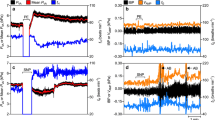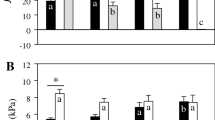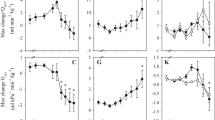Summary
Different molluscan groups have evolved functionally specialised cardiovascular systems in response to varied behavioural and environmental demands, making the study of cardiovascular regulation in these animals a fascinating area for research. Currently, such research is frustrated by the lack of data on the in vivo performance of these systems, although, where examined, increased cardiac output appears to be accommodated by a change in stroke volume. This paper considers the in vivo regulation of cardiac output, primarily by extrapolating from in vivo experiments, and proposes the following three hypotheses for future study.
-
1.
The increase in stroke volume is critically dependent on the phasic action of acetylcholine, expanding the end-diastolic volume of the ventricle for the same returning venous pressure.
-
2.
Circulating cardioactive peptides will set the level of myocardial tone on a sliding scale, against which the action of both intrinsic and extrinsic factors are expressed.
-
3.
In extreme cases, the inherent myogenicity of the heart may depend on the level of a circulating peptide. Here, the organ might be better described as humourogenic, rather than myogenic.
Similar content being viewed by others
References
Bourne, G. B., and Redmond, J. R., Hemodynamics of the pink abaloneHaliotus corrugata (Mollusca, Gastropoda) 1. Pressure relations and pressure gradients in the intact animal. J. exp. Zool.200 (1977) 9–16.
Devlin, C. L., The effect of three calcium antagonists on the molluscan cardioactive substances FMRFamide and 5-hydroxtryptamine. M. Sc. Thesis, University of Rhode Island, USA 1985.
Ellington, W. R., Cardiac energy metabolism in relation to work demand and habitat in bivalve and gastropod mollucs., in: Circulation, Respiration and Metabolism, pp. 356–366. Ed. R. Gilles. Springer-Verlag, Berlin, Heidelberg 1985.
Foti, L., Genoino, I. T., and Agnisola, G.,In vitro cardiac performance inOctopus vulgaris (Lam). Comp. Biochem. Physiol.82C (1985) 483–488.
Farrell, T., Cardiovascular and hemodynamic energetics of fishes. In: Circulation, Respiration and Metabolism, pp. 377–385. Ed. R. Gilles. Springer-Verlag, Berlin, Heidelberg 1985.
Getting, P. A., Neural control of behaviour in gastropods, in: The Mollusca, vol. 8 (1), pp. 269–334. Ed. A. O. D. Willows, Academic Press, New York, London 1985.
Greenberg, M. J.: Ex Bouillabaisse Lux: The charm of comparative physiology and biochemistry. Am. Zool.25 (1985) 737–749.
Greenberg, M. J., and Price, D. A., FMRFamide, a cardioexcitatory neuropeptide in molluscs: An agent in search of a mission. Am. Zool.19 (1979) 163–174.
Hill, R. B., Effects of 5-hydroxytryptamine on action potentials and on contractile force in the ventricle ofDolabella auricularia. J. exp. Biol.61 (1974) 529–539.
Hill, R. B., and Irisawa, H., The immediate effect of changed perfusion pressure and subsequent adaption in the isolated ventricle of the marine gastropodRapana thomasiana (Prosobranchia). Life Sci.6 (1967) 1691–1696.
Hill, R. B., and Yantorno, R. E., Inotropism and contracture in aplysiid ventricles as related to the action of neurohumors on the resting and action potentials of molluscan hearts. Am. Zool.19 (1979) 145–162.
Houlihan, D. F., Duthie, G. G., Smith, P. J. S., Wells, M. J., and Wells, J., Ventilation and circulation during exercise inOctopus vulgaris. J. Comp. Physiol.156 (1985) 683–689.
Irisawa, H., Kobayashi, M., and Matsubayashi, T., Action potentials of oyster myocardium. Jap. J. Physiol.11 (1961a) 162–168.
Jones, H. D., Hydrostatic pressures within the heart and pericardium ofPatella vulgata L. Comp. Biochem. Physiol.34 (1970) 263–272.
Jones, H. D., The circulatory systems of gastropods and bivalves, in: The Mollusca, vol. 15 (2), pp. 189–238. Eds A. S. M. Saleuddin and K. M. Wilbur. Academic Press, New York/London 1983.
Kawakami, and Kobayashi, M., Pharmacological approach to the analysis of regulation of molluscan heart activity. Zool. Sci.1 (1984) 389–397.
Kiss, T., and S. Rozsa, K., Site of action of 5-hydroxytryptamine on the membrane of heart muscle cells ofHelix pomatia L. Ann. Biol. Tihany42 (1975) 61–72.
Koch, U. T., and Koester, J., Time sharing of heart power: Cardiovascular adaptions to food-arousal inAplysia. J. comp. Physiol.149 (1982) 31–42.
Koch, U. T., Koester, J., and Weiss, K. R., Neuronal mediation of cardiovascular effects of food arousal inAplysia. J. Neurophysiol.51 (1984) 126–135.
Koester, J., Mayeri, E., Liebeswar, G., and Kandel, E. R., Neural control of circulation inAplysia. II Interneurons. J Neurophysiol.37 (1974) 476–496.
Kuwasawa, K., Effects of ACh and IJPs on the av valve and the ventricle ofDolabella auricularia. Am. Zool.19 (1979) 129–143.
Kuwasawa, K., and Hill, R. B., Regulation of ventricular rhythmicity in the hearts of prosobranch gastropods, in: Neurobiology of Invertebrates: Mechanisms of Rhythm Regulation, pp. 143–165. Ed. J. Salanki. Akademiai Kiado, Budapest 1973.
Lehman, H. K., Price, D. A., and Greenberg, M. J., The FMRFamide-like peptide ofAplysia is FMRFamide. Biol. Bull.167 (1984) 460–466.
Lever, J., and Boer, H. H. (Eds) Molluscan Neuroendocrinology. North-Holland, Amsterdam 1983.
Mountcastle, V. B. (Ed.), Medical Physiology, vol. 2. The C. V. Mosby Company, St. Louis 1974.
Nagle, G. T., The molluscan neuropeptide FMRFamide. Calcium-dependent release and blood levels inMacrocallista (Bivalvia). Life Sci30 (1982) 803–807.
Nomura, H., the effects of stretching on the intracellular action potential from the cardiac muscle fibre of the marine mollusc,Dolabella auricula. Sci. Rep. Tokyo Kyoiku Daigaku11 (1963) 253–269.
Painter, S. D., FMRFamide inhibition of a molluscan heart is accompanied by increases in cyclic AMP. Neuropeptides3 (1982) 19–27.
Painter S. D., and Greenberg, M. J., A survey of the responses of bivalve hearts to the molluscan neuropeptide FMRFamide and to 5-hydroxytryptamine. Biol. Bull162 (1982) 311–332.
Patterson, S. W., and Starling, E. H., Mechanical factors which determine the output of ventricles. J. Physiol., Lond.48 (1914) 357.
Price, D. A., and Greenberg, M. J., The structure of a molluscan cardioexcitatory neuropeptide. Science197 (1977) 670–671.
Price, D. A., Cottrell, G. A., Doble, K. E., Greenberg, M. J., Jorenby, W., Lehman, H. K., and Riehm, J. P., A novel FMRFamide-related peptide inHelix: pQDPFLRFamide. Biol. Bull169 (1985) 256–266.
Skramlik, E., Über den Kreislauf bei den Weichtieren. Ergebn. Biol.18 (1941) 88–286.
Smith, P. J. S., Studies on the circulatory organs of the octopus,Eledone cirrhosa (Lam.). Ph.D. Thesis, University of Aberdeen, Scotland 1979.
Smith, P. J. S., The role of venous pressure in regulation of output from the heart of the octopus,Eledone cirrhosa (Lam.). J. exp. Biol.93 (1981) 243–255.
Smith, P. J. S., Molluscan circulation: Haemodynamics and the heart, in: Circulation, Respiration and Metabolism, pp. 344–355. Ed. R. Gilles. Springer-Verlag, Berlin, Heidelberg 1985a.
Smith, P. J. S., Cardiac performance in response to loading pressures for two molluscan species,Busycon canaliculatum (L.) (Gastropoda) andMercenaria mercenaria (L.) (Bivalvia). J. exp. Biol.119 (1985b) 301–320.
Smith, P. J. S., Energetics of the isolatedAplysia heart in response to 5-HT and FMRFamide. (1987). in preparation.
Smith, P. J. S., and Boyle, P. R., The cardiac innervation ofEledone cirrhosa (Lamarck) (Mollusca: Cephalopoda). Phil. Trans R. Soc. (Lond.)B 300 (1983) 493–511.
Smith, P. J. S., Duthie, G. G., Wells, M. J., and Houlihan, D. F., Continuous recording of arterial blood PO2 inOctopus vulgaris during progressive hypoxia and movement. J. exp. Biol.117 (1985) 475–479.
Smith, P. J. S., and Hill, R. B., Cardiac performance in response to loading pressures and perfusion with 5-hydroxytryptamine in the isolated heart ofBusycon canaliculatum (Gastropoda, Prosobranchia). J. exp. Biol.123 (1986) 243–253.
Smith, P. J. S., and Hill, R. B., Modulation of output from an isolated gastropod heart: Effects of acetylcholine and FMRFamide. J. exp. Biol. (1987) in press.
Straub, W., Zur Physiologie des Aplysienherzen. Pflügers Arch. ges. Physiol.86 (1901) 504–532.
Straub, W., Fortgesetzte Studien am Aplysienherzen (Dynamik, Kreislauf und dessen Innervation) nebst Bemerkungen zur vergleichenden Muskelphysiologie. Pflügers Arch. ges. Physiol.103 (1904) 429–449.
Thompson, R. J., Livingston, D. R., and de Zwaam, A., Physiological and biochemical aspects of valve closure in the Giant ScallopPlacopecten magellanicus. J. comp. Physiol.137 (1980) 97–104.
Tublitz, N. J., and Truman, J. W., Insect cardioative peptides. II. Neurohormonal control of heart activity by two cardioactive peptides in the tobacco hawkmoth,Manduca sexta. J. exp. Biol.114 (1985) 381–396.
Wells, M. J., The heartbeat ofOctopus vulgaris. J. exp. Biol.78 (1979) 87–104.
Wells, M. J., Circulation in cephalopods, in: The Mollusca, vol. 5, pp. 239–290. Eds A. S. M. Saleuddin and K. M. Wilbur. Academic Press, New York 1983.
Wells, M. J., Duthie, G. G., Houlihan, D. F., Smith, P. J. S., and Wells, J., Blood flow and pressure changes in exercising octopuses. J. exp. Biol. (1987) in press.
Wells, M. J., O'Dor, R. K., Mangold, K., and Wells, J., Oxygen consumption in movement byOctopus. Mar. Behav. Physiol.9, (1983) 289–303.
Wells, M. J., and Smith, P. J. S., The performance of theOctopus circulatory system: A triumph of engineering over design. Experientia43 (1987) 487–499.
Welsh, J. H., Neurohormones, in: The Hormones, pp. 97–151. Eds G. Pincus and K. V. Thimann. Academic Press, New York 1955.
Wilkens, L. A., Electrophysiological studies on the heart of the bivalve molluscModiolus demissus. II. Ionic basis of the action potential. J. exp. Biol.56 (1972) 293–310.
Wilkens, L. A., and Greenberg, M. J., Effects of acetylcholine and 5-hydroxytryptamine and their ionic mechanism of action on the electrical and mechanical activity of molluscan heart smooth muscle. Comp. Biochem. Physiol.45 (1973) 637–651.
Author information
Authors and Affiliations
Rights and permissions
About this article
Cite this article
Smith, P.J.S. Cardiac output in the Mollusca: Scope and regulation. Experientia 43, 956–965 (1987). https://doi.org/10.1007/BF01952210
Published:
Issue Date:
DOI: https://doi.org/10.1007/BF01952210




